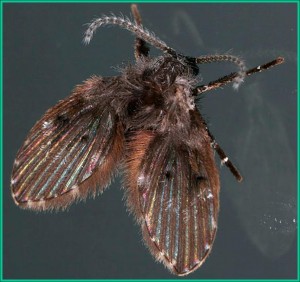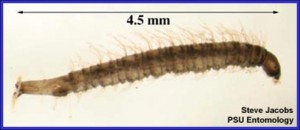
Moth flies or Drain flies
Moth flies or Drain flies (Psychoda sp.)
In nature, moth fly larvae normally occur in aquatic habitats that experience intermittent submersion. They reproduce in polluted, shallow water or highly moist organic solids where they feed on decaying organic material in mud, moss or water. In homes, the adult flies are most likely found on the walls of the bathrooms, kitchens, basements and other locations where sewer drains and plumbing fixtures are located. The flies are poor fliers and usually are found close to the drain or area of origin. Moth fly larvae are known to live in drain traps, garbage disposals, toilet tanks, sides of drains and overflow pipes in homes, septic tanks and moist compost. They have also been found in dirty garbage containers, rain barrels and tree holes and other wet situations where organic material accumulates. Moth flies do not bite and are not known to transmit disease of any sort. The larvae can be controlled by eliminating or reducing breeding sites by thoroughly cleaning the drain lines, plumbing fixtures or eliminating possible wet areas around leaky pipes.
Eggs, which can hatch in 32 to 48 hours at 70 degrees F, are laid in and on the moist media. Larvae feed on the decaying organic matter, microorganisms, algae and sediment in the media. Larvae mature in 9 to 15 days and are considered valuable organisms along with the organic film in purifying sewage water. Larvae live in the organic film, breathing through tubes and feeding on sediment, decaying vegetation, along with microscopic plants and animals in filters at sewage plants. Pupae occur in or on the surface of the breeding media and, after 20 to 40 hours, new adults emerge.
The life cycle can be completed in one to three weeks. Adults live about two weeks, with old ones dying and new ones emerging. They feed on flower nectar and polluted water. During the day, adults rest in shaded areas or on walls near plumbing fixtures and on the sides of showers and tubs. Most activity occurs during the evening when these flies are seen hovering about drains and sinks. They may breed in large numbers at sewage filter plants and then may be carried by prevailing wind to nearby homes up to a mile away. Adults are small enough to pass through ordinary window screening.
Drain flies do not bite humans but may become a nuisance by their presence in large populations. Sometimes it takes persistent effort to eradicate an infestation in the home. Concentrate on eliminating larval breeding sites from drains in floors, sinks, wash basins, bathtubs, etc. Sometimes the source of the problem is a nearby filter plant.
To detect if flies are indeed coming from a drain, one needs to cover the opening during a down time with a series of glue boards. Keep the glue boards from adhering to the floor by making a small collar for the drains. Use some heavy cardboard and form it into a circle slightly larger than the drain cover (1 inch tall). Leave in place overnight or for a few days to catch flies. Also, tap loose ceramic floor tile with a broom handle in a wet room near the drain. Lift, clean and re-cement tiles.
Often the most effective method is to clean the drain pipes and traps to eliminate the gelatinous rotting, organic matter, thereby eliminating the larval food source. This can be accomplished by using DF-5000 Drain Fly Eliminator, a nonacid, noncaustic bacterial product that rapidly biodegrades the organic matter.
DF 5000 Gel is a highly selective active bacteria complex (not an insecticide) available in a convenient, ready-to-use 32 ounce container to rapidly attack and destroy the organic matter that supports drain fly development. When applied, the gel clings to pipes and traps. Pour the product around the drain edge to coat the sides. Treat five days in a row and then monthly. It does not harm plastic, metal or glass plumbing, and will keep drain lines flowing freely. Bleach should not be used in conjunction with this product as it will kill much of the beneficial bacteria and reduce its effectiveness. This product can be purchased on the web from suppliers like Do-it-Yourself Pest Control at http://www.doyourownpestcontrol.com/df5000.htm
Alternative methods include cleaning pipes and traps with a good, stiff, long-handled brush. It is best to remove the drain trap and use a “snake” in clogged drains to clean the pipes of all gelatinous material. If using mechanical means, flush lines with boiling water and bleach to remove any material left behind by the cleaning process. Caustic drain cleaners may also be used, although they are not as effective as other means and must NEVER be followed with bleach since Chlorine gas can be released if the two mix in the drain line.
Clean dirty garbage containers, wet lint under the washing machine, and even standing water in containers under houseplant pots. Outside the home, inspect air conditioners, bird baths, shallow stagnant pools of water and sewage treatment facilities upwind as adult flies will travel with the wind.
Adults can be controlled with the application of a household aerosol insecticide (like Raid) or a good flyswatter.
Be sure to read and follow all instructions and safety precautions found on the label before using any pesticide.





 Print
Print Email
Email




